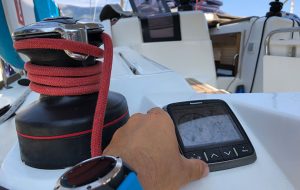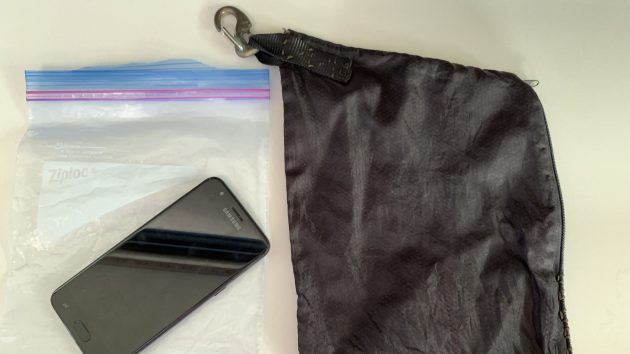Yachting Monthly’s expert panel of cruisers gather their top tips and expert advice when it comes to using and understanding sailing instruments

Sailing instruments are a key part of our boating experience and have been since before the invention of the chronometer.
But there is no denying that as technology evolves sailing instrumentation has become ever more helpful and wide spread.
Here, our panel of expert cruisers gather some of their best advice on using sailing instrumentation to your advantage.
Makeshift mobile phone mast – Pete Goss

Wrap up a mobile to create your own phone mast. Credit: Pete Goss
We always carry a small waterproof bag for when we are tucked away in a safe, sheltered anchorage as a big weather system vents its spleen.
Unfortunately, these wonderful bolt holes are often mobile phone black spots, and so cut out all the wonderfully detailed weather than only a mobile phone can access.
I know we have the shipping forecast but sometimes I feel that a bit more detail is required before breaking cover.
Using on of our phones as a mobile hotspot in our waterproof bag at the top of the mast often find the elusive signal, which also means we can let family and friends know we are OK.
Checking GPS position – Dag Pike

If your depth readout doesn’t match the chart then you should check your GPS position. Credit: Dag Pike
These days you tend to trust GPS positions implicitly.
It will pinpoint your position and the sounder can show the depth.
If the sounder depth does not match that shown on the chart then take this as a warning sign.
GPS jamming means there will be no position and depending on your GPS you may not be aware of this. Spoofing can be another problem.
-
BEST Webhosting
Explore a comprehensive array of web hosting services designed to cater to various needs. Whether you’re an individual looking for reliable personal hosting or a business requiring high-performance solutions, BEST Webhosting offers tailored options to ensure optimal website performance, robust security, and 24/7 support.
-
Unveiling the Pillars of Web Hosting
Web hosting is the backbone of a digital presence, providing the infrastructure necessary to publish and maintain websites online. This article delves deep into the essentials of web hosting, guiding individuals and businesses to make informed decisions. Learn about hosting types, server performance, and scalability options to choose the perfect fit for your online goals.
-
Digital Experience and Coding a New Website
Building a website today involves more than creating an online presence; it’s about delivering an exceptional digital experience. This piece explores modern website design principles, user experience strategies, and advanced coding techniques. It highlights how a well-crafted website can effectively convey your brand message, captivate audiences, and drive business success.
-
How to Buy a .com.au Domain: A Buyer’s Guide to .com.au Domains
This guide is a must-read for startups and established businesses aiming to enhance their Australian online presence. Learn the steps to secure a .com.au domain that aligns perfectly with your brand identity. The article provides insights into domain registration requirements, tips for choosing a memorable domain name, and the benefits of a local domain for SEO.
- Incredible Ideas deserve Incredible DomainsWith Rapid Registration, your domain is registered almost instantly, meaning you don’t have to wait to get your business or name online!
-
Edge of Technology, Digital Transformation, and Cloud Computing
Staying competitive in today’s fast-paced digital landscape requires leveraging cutting-edge technologies. This article explores the vital roles of Digital Transformation (DT) and Cloud Computing in modern business strategies. Understand how these technologies drive efficiency, foster innovation, and enable organisations to scale operations seamlessly.
-
The Best WordPress Plugins for Email Marketing to Grow and Engage Your Subscriber List
Email marketing remains a powerful tool for audience engagement and lead conversion. Discover top WordPress plugins like Mailchimp, Constant Contact, OptinMonster, and Thrive Leads. This article provides detailed guidance on creating effective opt-in forms, segmenting email lists, automating campaigns, and tracking metrics for successful email marketing strategies.
-
The Best WordPress Caching Plugins to Optimize Site Speed and Performance
Website speed and performance are crucial for user experience and SEO rankings. This detailed review covers the most effective WordPress caching plugins, including W3 Total Cache, WP Super Cache, WP Rocket, WP Fastest Cache, and LiteSpeed Cache. Learn how these plugins enhance site performance by minimising load times and optimising server resources.
This could be the time to rediscover those long lost skills of position fixing without GPS.
Generating power afloat – Tony Curphey

Having a generator for backup is a good idea if sailing further afield. Credit: Tony Curphey
Roughly 95% of electrical power on my Nicholson 32, Nicola Deux is from her twin 125 Watt solar panels.
The main engine is also a source of charging but I don’t like to use it for that purpose, although I do run the engine for an hour or so every week or two at sea to keep it oiled, dry and supple.
As they say, use it or lose it. If that hour or so coincides with a drop of calm weather, then so much the better.
However, for backup I have a small Honda 1kW generator which has been onboard for several years.
Nicky was equipped with a 240v ring main system when I bought her, and a smart charger.
Start the genny, plug in the mains power lead and switch on the smart charger and all the batteries are fully charged within an hour or so.
Several times in the Southern Ocean, I’ve had periods of a week or more with cloud too heavy to activate the solar panels.
The generator only sips petrol in the most frugal manner and stores easily in the saloon.
Check the depth setting – Oliver Perkins

Ensure you know where the depth reads from. Credit: Oliver Perkins
When updating our navigation systems, a professional reset our depth sounder to read off the waterline, instead of beneath the keel.
A crew member, unaware of the change, led us straight onto the mud up a shallow channel, confident we still had a metre below us.
To avoid this, I’ll now ensure all crew are aware of where the sounder reads from.
In addition, we discovered that the sounder had been set to under-read the depth by 30cm.
This measuring mismatch is especially common on charter boats, where companies are cautious to avoid groundings.
Know your systems – Oliver Perkins

Take the time to understand how
electronic gear, like your chartplotter,
works so you can concentrate on helming. Credit: Oliver Perkins
Make sure you know your way around the boat’s electronics, especially complicated equipment like a chartplotter.
Recently I unexpectedly had to enter an unfamiliar harbour in the dark. I was navigating using a chartplotter in the cockpit, but couldn’t work out how to turn the brightness down.
This meant I couldn’t see where I was going and spent half the time distracted trying to change the setting.
Fortunately my crew could guide us in, but shorthanded I would have been going in blind.
I’d suggest thoroughly understanding your chartplotter especially brightness, chart detail levels and most importantly MOB settings.
There is little point in having the kit if you can’t work out how to use it when you are really relying on it.
Enjoyed reading this?
A subscription to Yachting Monthly magazine costs around 40% less than the cover price.
Print and digital editions are available through Magazines Direct – where you can also find the latest deals.
YM is packed with information to help you get the most from your time on the water.
-
-
- Take your seamanship to the next level with tips, advice and skills from our experts
- Impartial in-depth reviews of the latest yachts and equipment
- Cruising guides to help you reach those dream destinations
-
Follow us on Facebook, Twitter and Instagram.
The post Expert advice: sailing instruments appeared first on Yachting Monthly.




